

Event Solutions

Our Work

Digital Signage vs. Traditional Signage: Why Digital is the Way Forward
When it comes to signage, we've all seen the familiar posters, banners, and billboards in storefronts, offices, and public spaces. These static, printed signs have been a staple for decades. However, with the rapid advancement of technology, many businesses are now making the shift to digital signage. But what’s the real difference, and why is digital signage increasingly the better option? Let’s break it down.
1. Flexibility: A Game Changer
One of the biggest advantages of digital signage is its flexibility. Traditional signage is fixed. Once that poster or banner is printed, it’s not easy to change it. Want to update a promotion, change a product listing, or correct a mistake? You’ll have to reprint and reinstall new materials.
Digital signage, however, can be updated instantly. Whether it’s a flash sale, a new menu item, or important announcements, you can change the content remotely at the click of a button. This is particularly beneficial if you have multiple locations — no need to print and distribute new signage for each one.
2. Cost-Effectiveness Over Time
At first glance, digital signage may seem like a hefty investment. Between purchasing screens, software, and installation, the initial costs can be higher than traditional printed signage. However, digital signage saves money in the long run.
Why? With traditional signage, you’re constantly paying for new prints and materials every time you need to make a change. Additionally, the labor involved in replacing and installing these materials adds to the overall cost. With digital signage, once your screens are set up, you can continuously update content at minimal cost, and there’s no need to reprint. This makes it a more cost-effective solution in the long term.
3. Engagement: The Power of Interaction
Let’s face it — we’ve all walked past a static sign without giving it a second glance. Traditional signage often struggles to capture attention in a crowded, information-saturated world. It’s static, which makes it easy to ignore.
Digital signage, on the other hand, grabs attention with motion, color, and interactivity. Whether it’s a video, animation, or real-time social media feed, digital signage allows you to engage your audience in ways that traditional signs just can’t match. In addition, interactive features, like touchscreens and QR codes, offer opportunities for deeper engagement, making it not just a one-way communication tool but an interactive experience for the viewer.
4. Branding: More Creative Possibilities
Traditional signage is often limited to a fixed size and layout, meaning your branding opportunities are confined to the space you have. You can’t easily play with motion or include multimedia to better showcase your brand’s personality.
With digital signage, the creative possibilities are nearly endless. You can incorporate videos, animations, and dynamic content to showcase your brand in the most visually appealing and engaging way. Whether it’s playing brand videos, incorporating social media feeds, or using motion graphics, digital signage allows for a richer, more immersive branding experience.
5. Sustainability: A Step Toward Greener Practices
As sustainability becomes more important, businesses are looking for ways to reduce waste and minimize their environmental footprint. Traditional signage requires constant printing, shipping, and disposal of old materials. That means more paper, ink, and plastic used — all of which contribute to waste.
In contrast, digital signage eliminates the need for printed materials. There’s no waste from outdated posters, and the content can be reused and updated indefinitely. Additionally, digital displays often come with energy-saving settings, further reducing environmental impact. Going digital is a more sustainable option for businesses looking to align with eco-friendly practices.
6. Analytics: Measure Your Impact
With traditional signage, it’s hard to measure its effectiveness. Did that poster actually get noticed? Were people interested in the promotion? You can guess, but you can’t really track its performance.
Digital signage solves this problem by offering the ability to gather real-time data and analytics. With digital displays, you can track how many people engage with the content, which messages are most effective, and how long people are interacting with your signage. This data gives you valuable insights into customer behavior and helps you refine your strategy for better results.
Conclusion: Digital is the Way Forward
While traditional signage still has its place in many environments, it’s clear that digital signage offers numerous advantages that make it the better choice for many businesses. Its flexibility, cost-effectiveness, ability to engage audiences, and endless creative possibilities make it a powerful tool for communication and branding.
If you’re still relying on static signs for your messaging, it might be time to make the switch to digital. Whether you’re looking to boost engagement, streamline content updates, or simply elevate your brand, digital signage is the future — and it’s here now.